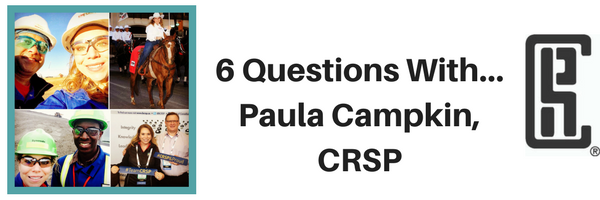|
What is the most misunderstood aspect of your job? Some people do not understand that health and safety is a profession. Many see safety as part of the company overhead; a necessary cost of doing business. However, safety professionals can operate at a strategic level and more and more are holding senior executive positions within organizations. From the field to the board room; safety professionals can make that transition. |
|
|
What does a typical day look like for you? In my current role as Vice President and Chief Safety Officer of Energy Safety Canada, a merger of Enform and Oil Sands Safety Association, I am fortunate enough to work for an organization that can impact safety performance of an entire industry. A typical day for me may include; meetings with various industry stakeholders including; oil and gas executive, employers, regulators and associations, strategic planning for industry safety initiatives, chairing the Petroleum Safety Conference, attending board and committee meetings, field visits to engage with industry stakeholders, etc |
|
|
Why did you chose this field? Growing up in small town Alberta, my Dad spent his entire career working in the oil patch and my Mom was the director of nursing so safety was ingrained in me from an early age. I can remember my Dad teaching me to back into parking spots, how to change a tire, what to do in the event of a tornado, etc. Like many health and safety professionals, my career path originally started off in a different direction. With a degree in industrial psychology under my belt, I began my career working in Human Resources at Coram for PCL Construction. After a short time, I was given a dual HR and health and safety role, and that was where I discovered a different purpose. Although I enjoy the HR field, something about health and safety spoke to me. I found I had more of an ability to make an impact at the operations level. |
|
|
What is the most gratifying part of being a safety professional who is certified as a CRSP? The designation represents being a part of a group of like-minded professionals who are committed to occupational health and safety. I also like that the BCRSP certification framework offers several layers of control to confirm people holding the designation are operating at a certain level; both technically and ethically. |
|
|
Is there anything you’d like people to know about the field? I’m excited to announce that a group of female safety leaders in Alberta launched a society to foster the advancement of women working in the occupational health and safety profession. The Women in Occupational Health & Safety Society (WOHSS) was incorporated by the Government of Alberta Societies Act with a mission to foster the advancement of women working in health and safety in Alberta. Although the number of women entering the profession is rising, in 2016, only 38% of the safety professionals certified by the Board of Canadian Registered Safety Professionals (BCRSP), the certifying body for health and safety professional in Canada, were female. According to statistics from the BCRSP, of all safety professionals certified from 1976-2016, only 30% were female. As the Chairperson of WOHSS I am looking forward to connecting with women at all stages of their career. |
|
|
Best part of your day? I like the variety. In the past few years alone, I have been on drilling rigs in Northern BC, on a Frac job in Edson, on a SAGD job in Fort MacMurray, upside down in a helicopter simulator in Nova Scotia, etc. It is never boring! |
News
Subscribe to our e-newsletter
and stay up to date on BCRSP news, event and more!







